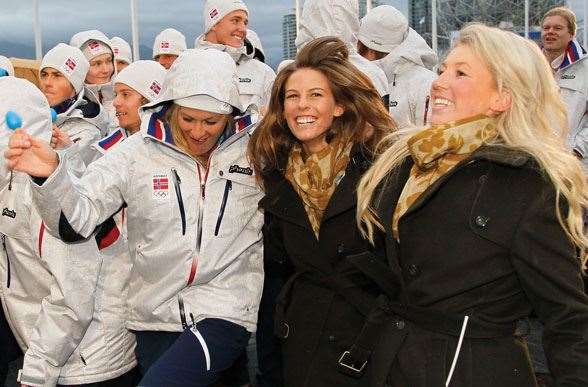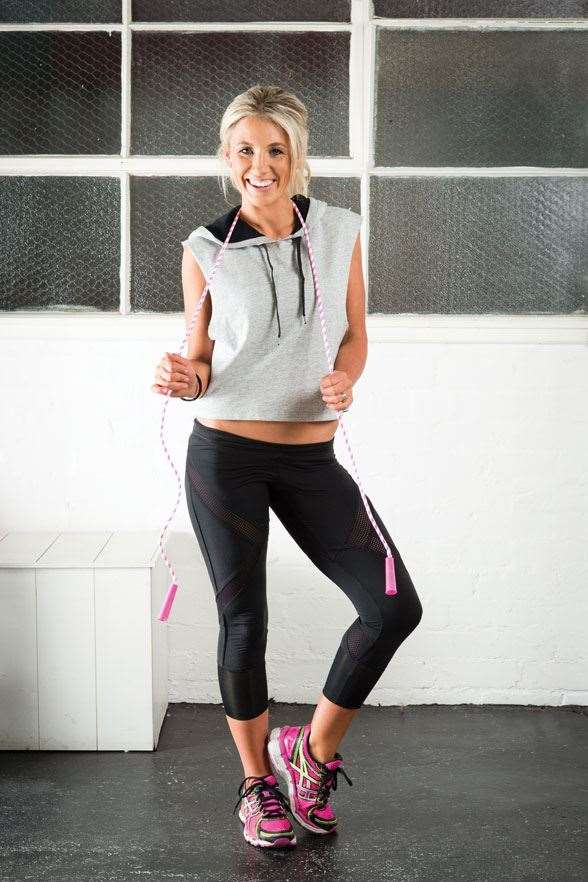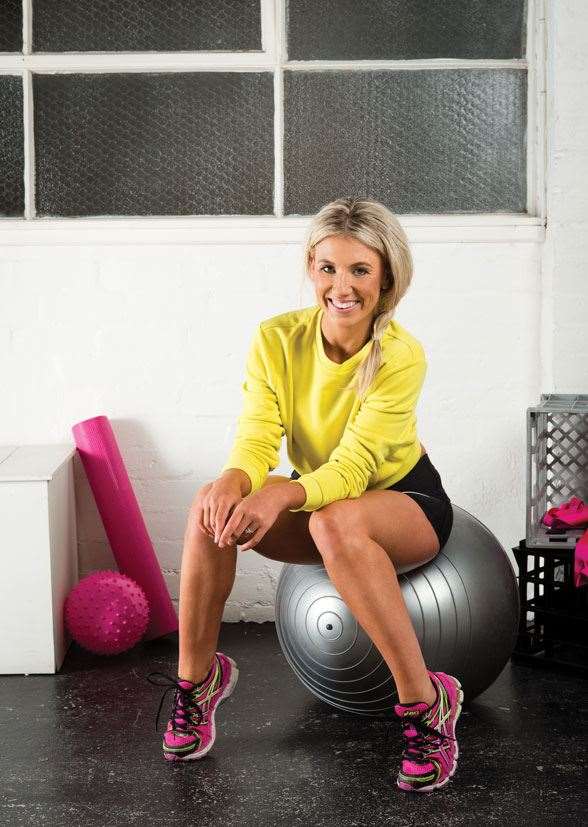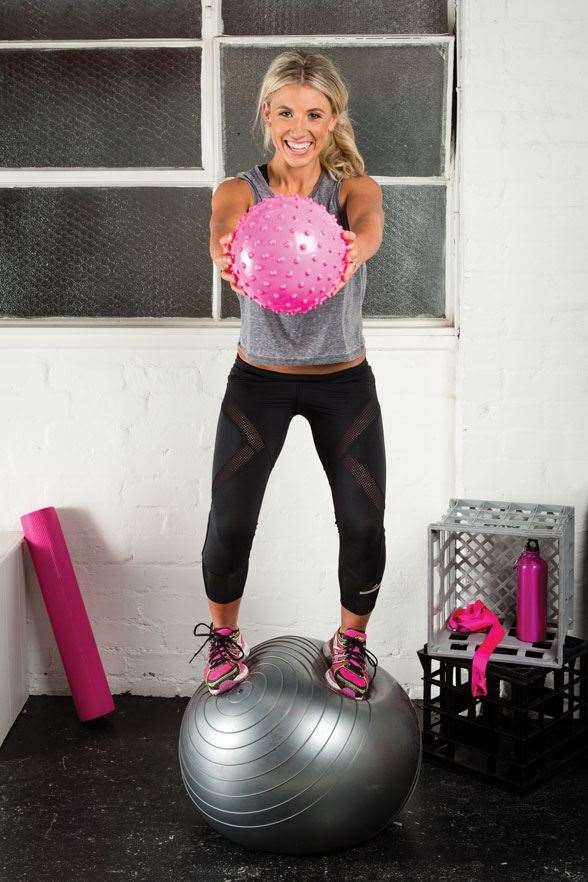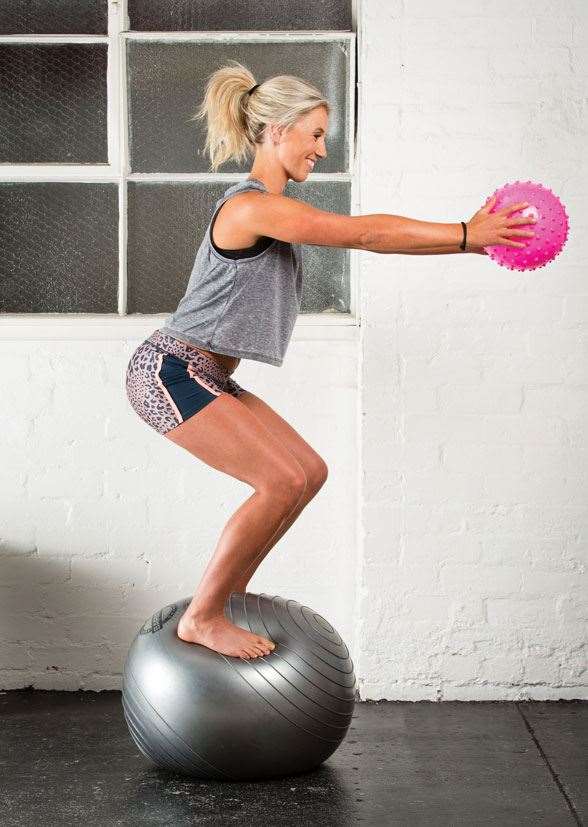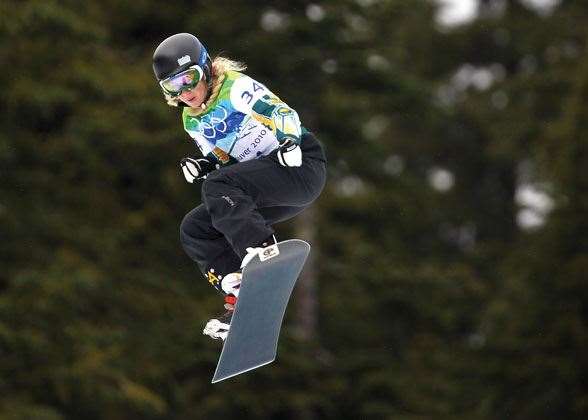Injury Recovery 101 with a former Olympic Aussie snowboarder.
It's been a great snow season in the Australian Alps, with record falls and fabulous conditions bringing all the usual suspects out of the woodwork – except for one. For Steph Prem, the mountains of powder have been something of a torment, as this is the first Australian winter she can remember when she’s been anchored at sea level.
But when you’re a former Olympic snowboarder now making a name for yourself as a media commentator on the sport (last seen in the studio on Ten’s Sochi coverage), motivational speaker, personal trainer and pilates instructor, with your own studio, Premium Performance, recently opened in Melbourne’s Chapel Street, you have your hands rather full – and the mountains will have to wait. Steph Prem (nee Hickey when competing in the boardercross at Vancouver in 2010) is 29, a snowball of energy and vitality, with one not-so-obvious secret to her story: a shocking crash on the snow just weeks after the 2010 Olympics bent her very badly out of shape and wrecked her competitive career. It has since sent her scouring the medical universe for methods and insights to control her chronic pain and get herself back on her feet – and her snowboard! Most of us can learn a thing or two from her tenacity and what she has learned – and she is happy to share. Bend an ear.
FIRST STEPS
“It’s quite funny: I wasn’t a great sportsperson when I was young – ball sports were definitely not my thing. And I wasn’t always going to be into snowsports – I actually danced for 15 years, all sorts of styles: ballet, jazz, contemporary, funk, tap ... I sort of did everything from about three years old, competing at national level with my jazz and contemporary. I went on to study musical theatre, and actually finished half a drama and dance degree at Deakin University. But I put all that aside when my professional snowboarding career took over.
“Until I was about 17 or 18 it had only been a hobby. Maybe I didn’t realise quite how good I was at it, but the balance and the agility from the dancing background crossed over beautifully. I’ve always had a competitive drive and a bit of white line fever. And yeah, I used to race the slalom, where you go around the gates in a timed event. But then boardercross became an Olympic event in 2006, which I’d been dabbling in on the side of my racing career. And I just absolutely loved it. It was a lot more exciting than just the racing – I loved the jumps and the bumps and the thrills and the skills. And the fact that there were three other people on the course with you at the same time made it really exciting. So when I was 18 or so, I made the leap, deciding it could be a professional career.”
BACK TO EARTH
“About six weeks after the Vancouver Olympics, I had a fairly horrific accident. It was at the World Cup finals in Italy – the last race of the season. I was probably burnt out from a huge season on the snow and getting to the Olympics. And I’d already had a bad crash at the Olympics, so my body probably wasn’t in the best shape. But unfortunately I came off a jump very badly – very wrong, uneven. I knew in the air that I was in a lot of trouble. And I didn’t land on my feet – I landed on my back. I fractured a couple of vertebrae, compressed a few disks, dislocated my hip, broke five ribs. I took all the impact through my left thigh. It was definitely the worst accident I’ve ever had – I’d had a solid career without anything too serious happening. But that one knocked me for six.
“I had to wait for about six weeks before I could fly home to the medical staff that I knew and was confident with. They were all back in Australia, but I wasn’t allowed to fly because I was covered in severe haematomas. It was a horrible waiting game before I was given the all-clear.”
HEADS DOWN
“Having this accident has totally opened my eyes to the world of rehabilitation – especially clinical pilates. I still need weekly treatment on my back. That’s what made me go and study clinical pilates and get my certificate in personal training: I had to learn to build myself up from the inside out again.
“Pilates works all the intrinsic muscles – it literally does work you from the inside out. It creates a lot of body awareness that you don’t get from many exercise and fitness programs. It’s a lot more mindful. And it’s a lot more specific, especially for injury. It involves a lot of functional movement, retraining your body and your mind to work properly, especially once you’ve been injured, or if you maybe have a bad posture, or you’ve grown up a certain way. I think a lot of people get yoga and pilates confused – you can say that yoga is a lot more focused on stretching and flexibility, whereas pilates is more focused on strength and body awareness.
“The clinical side of pilates is with the equipment – the reformer beds and all the spring-type work. You’re in very protected positions, so you can’t injure yourself. I’m a culprit myself: I used to think you wouldn’t feel like you’re getting enough of a workout in pilates. But I’ve learnt the hard way that pilates is pretty much the basis for every kind of fitness and exercise program you’ll ever do. And if you don’t have the basics right, you’re never going to get the rest of it correct. That’s what fascinated me.
“I found I was able to advance at it really quickly. I was very injured and limited in my motion, but there was so much work that I could still do – and that’s what I fell in love with.”
WORKING IT OUT
“When I studied pilates, I realised that it’s so relatable and transferrable to people who are having issues themselves with their bodies and their fitness. I just found from the mental and physical side of things that I was a good person to try and help people – even if it’s just getting their fitness back. Maybe it’s later in your life and you’re just stepping into the fitness world? But what I learned is really transferrable.
“I’m now running about 20 classes myself a week, which is an hour a class. I personally do two to three sessions myself a week. I’ve only just started going back to any kind of weight work, probably in the last year. I go to a trainer twice a week, just so I’m monitored due to injury and the nature of my work. I do circuit work – nothing dramatically heavy. A couple of compressed disks in the back make that a bit difficult – plus severe SIJ (sacroiliac joint) pain through my back. I have some really good days, but I still do have some really bad days.
“Yeah, I am getting better, but it’s a step by step process. And this year has been the best I’ve had. I absolutely love fitness, health and exercise – I’m completely addicted and obsessed with it. So I’m just glad I’m back and able to do it myself properly. And my business has been great because I’ve been able to enjoy it with other people the last few years. And inspire other people to love it as well.”
CONSUMING PASSIONS
“I’ve done a full overhaul of my diet in the last few years. For a long time after the accident I thought I might have chronic fatigue syndrome: I was just so exhausted. I changed everything in my training routine to try and fend off the sleepiness, but it wasn’t changing a thing. I went to see so many specialists and doctors ... Eventually someone said, ‘Are you sure you’re not allergic to anything?’ And I said, ‘No, I’ve been eating everything my whole life.’ And she said, ‘It could be gluten.’ And I said, ‘Not a chance!’ Leading up to the Olympics, all I did was carb load. And my spaghetti bolognaise was my go-to meal! And I’m married to an Austrian, so schnitzels are just a staple part of our diet!
“But I went and had the blood test. It came back very very positive. If you’re still not convinced – or if you’re like me and didn’t want to hear it – you then go and have a sample taken from your tummy. And sure enough that came back firing. And so that was it. When I came out the nurse handed me a sandwich and said, “Enjoy that – it might be the last one you ever eat.” And she was right. I changed my diet 48 hours later. But I went from an entire year where I’d have to have an afternoon nap every day because I was so exhausted, to not napping ever since. It’s completely changed my training regime, my lifestyle, everything.
“My husband’s been awesome and adapted the way he eats as well. You just have to avoid wheat, barley, rye and oats. And it’s a lot easier than you think; we’re so lucky in Australia that cafes and restaurants are easy at adapting and are so flexible. And the gluten-free thing is everywhere now. I love that I can go to a decent restaurant or cafe and not be that annoying person at the table who has to get the whole menu changed. So it’s not an issue at all and it’s made me a healthier person overall. And given me a lot more energy – especially now I’m running my own business.”
ON THE JUICE
“I’m absolutely addicted to and obsessed by juices. The green juice smoothie is a huge part of my life. I don’t go a day without one. My favourite would be kale, cucumber, coconut water, banana, chia seeds and spinach. Straight in the blender and turned into a smoothie. I swear by it and it definitely helps to keep my inflammation at bay. I do them on the go all the time when I’m running around like an idiot. And every month for a couple of days I do just a green juice cleansing – to rid my body of inflammation and crap. We all like to enjoy the good things, and we are an over-consuming population – I enjoy a glass of wine on the weekends and I love to eat some naughties sometimes. But the green juice is my go-to to keep me in line, especially for my inflammation and back pain.
“I don’t take any painkillers any more. I was on them for years, but now I try to keep it all plant-based, and doing juice cleanses is my biggest secret to a pain-free life.
“I don’t take any supplements any more, either – I used to. I used to take fish oils and daily vitamins and a lot of things like that. But in the last year I have gone completely off everything. I just drink a lot of herbal tea, a lot of water and a lot of green juice.
“In my regular diet, meat, fish and vegetables are my go-to. I try to keep it as clean as possible. I’m married to an Austrian and he’s an amazing cook – he makes me some beautiful European meals with the gluten-free version. I’ll never go past a gluten-free pancake. That’s my weakness – a good glass of pinot and a gluten-free pancake is the way to my heart.”
ALTERNATIVE WAYS
“Western medicine was great for the diagnosis of my injuries, but in the last two years I swear by Chinese medicine. I don’t go a week without acupuncture; if I do, I find I fall in a bit of a heap. It’s really good for my inflammation, for one, but also really good for my energy levels. It kickstarts me again.
“Inflammation has been probably my biggest enemy through the whole recovery – and ridding my body of inflammation has been the biggest challenge. So I go to a Chinese doctor who’s put me on to a lot of herbal and Chinese teas, and they really seem to help flush my body of inflammation.
“Due to the level of pain I was in, I became very open-minded about trying a lot of new things. My program now consists of all the bits and pieces that I’ve found have worked. I’ve got a treasure chest of people I go to. I get acupuncture in once a week, and I go to my masseuse, and I see a myotherapist as well. And obviously I’ve got my own pilates program that I go through every morning when I wake up – I do it religiously to wake me up and get me going. And that’s become my way of life.”
SLOPE STYLE
“Would you believe that I spend ten months of the year rehabbing my body just so that I can get on the snow a couple of months of the year? The will behind everything I do is to get myself out of pain – I don’t ever want to be off my snowboard ever again. I just love it so much. It’s a way of life for my husband and I – we live it and breathe it. I’ve had to let go of the competitive side of life that I love so much. But the whole lifestyle and adventure side of mountain life I still absolutely live and breathe – and I hope to be doing that till the day I die.”
Related Articles

Steph Prem
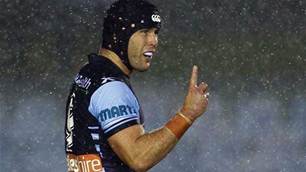
Training with the Cronulla Sharks' Michael Ennis



